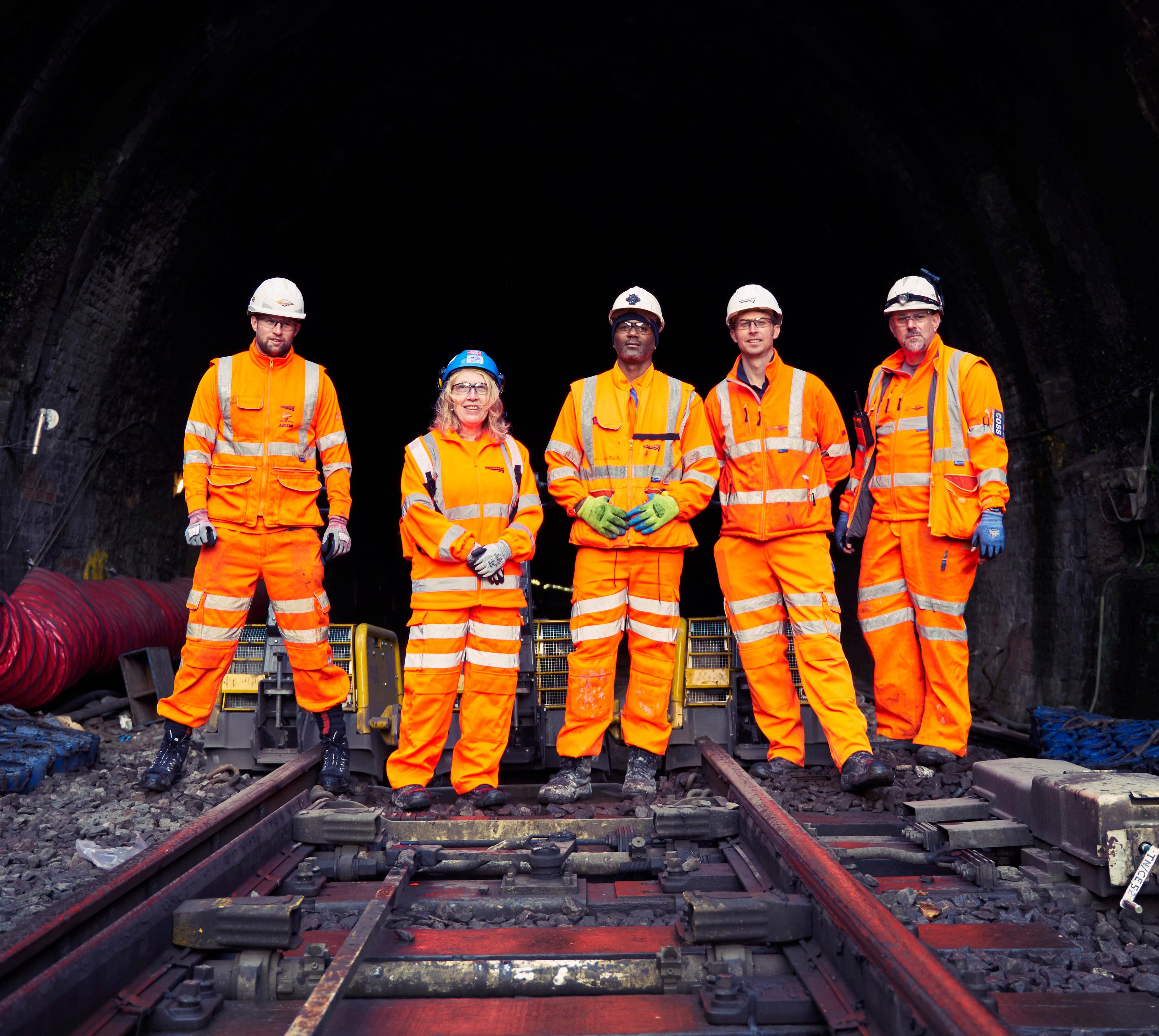


The Shield ISSUE 37, NOVEMBER 2022 THE SAFETY NEWSPAPER FOR RAIL PEOPLE southernshield.co.uk TUNNEL VISION Safety and performance go hand in hand at major project NO KIDDING Youngsters’ message for rail workers SEEPAGE 8 Ready for the road? PAGE 7 The facts on fatigue PAGE 3 Cross purpose PAGE 2 NOT SO FAST! A TRICKY tunnel track renewal was completed safely and on time thanks to clear communication and proper planning Colleagues from Colas Rail and Network Rail returned to Wadhurst in Sussex in October, a year after completing major embankment works, to renew the rails, ballast and sleepers in the 1,176 yard tunnel itself. Read the full story on pages 4 and 5.
THIS period we wanted to showcase our ‘Construction Route to Gold’ initiative within the Southern region capital delivery supply chain. The initiative aims to promote collaborative working behaviours, improve safety and quality standards, reduce costs caused by rework and embed a culture of continuous improvement.
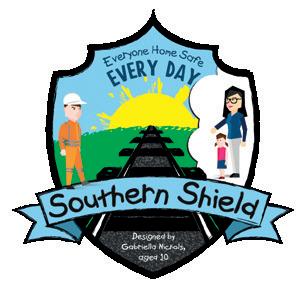
Each period, every active site is scored, and its performance and behaviours are rated as gold, silver or bronze. The scoring is generated from the data captured by the Network Rail construction managers using the CSA app. This period, the Surbiton congestion project (Wessex Route), delivered by Octavius Infrastructure was the highest scoring site in the Southern region.
The Shield
With 9.3m passengers entering and exiting the station, as well as 698,000 passenger interchanges, the station experiences high levels of congestion in the evening peak on Platforms 3 and 4.
As a result, there are safety concerns with passengers queueing to the edge of the platform as they wait to ascend the stairs. This also results in sub-threshold delays with trains not able to depart until the passenger congestion has cleared the platform. In order to rectify this, a rebuild project was developed to enable passengers to depart platforms quicker. This in turn allowed dispatch staff to enable trains to depart on time, and helped to alleviate congestion on platforms and the overbridge at peak times.
The team all take pride in providing a high quality of work throughout the build and regularly hold stand down talks to see if the site can be made safer. All targets to date have been met, despite working in a busy station environment. With all this going on the team still found time to work with the local community – particularly with local schools, including a recent project as part of the Surbiton Art Trail. We are incredibly proud of the work completed throughout our supply chain and will continue promoting the great work completed.
PRIMARY school pupils near Gatwick Airport station are growing their knowledge thanks a donation from rail colleagues.
Teams from the ongoing station upgrade have used left over low carbon concrete to create planters, which they have presented to local schools and hospices.

One of the most recent deliveries was to St Wilfred’s Catholic Primary School in Burgess Hill.
So far more than 200 planters have been donated to the local community.
CHANGES have been made to the rules around drink and drugs for railway workers.


Never driving or working under the influence of drugs or alcohol is one of Network Rail’s Lifesaving rules –and for good reason. The effect of working or driving under the influence can have a significant impact on safety, resulting in injury or possibly a fatality. One person’s
lapse in judgement can have an impact on themselves, their team and rail passengers.
But since 2018/2019 positive tests have been increasing every year. It’s a small proportion of our workforce but it’s still too many.
To help keep everyone safe, the Network Rail drugs and alcohol standard has been updated. The changes will take effect between now


and March 2023 and include increased testing. Twenty percent of all Network Rail colleagues, office and frontline workers, will be randomly selected for a drugs and alcohol test each year. Supply chain partners will continue to randomly test safety critical colleagues. It’s a matter that is taken very seriously –if you test positive, you can expect to lose your job.


The changes are designed to decrease the risk to Network Rail employees, contractors, supply chain and anyone who works for, or on behalf of, Network Rail.
The standards are also there to provide support to colleagues who have a concern about drug and alcohol misuse.
See page 3 for some of the support and advice services available.
ONE of highest-risk level crossings in the region has been made much safer thanks to teams from Network Rail, Atkins and other partners.


With busy traffic flows, school routes and two industrial estates nearby, the automatic half-barrier crossing at Parsonage Road in Horsham, West Sussex, was in need of an upgrade to reduce the risk to pedestrians, drivers and rail passengers.
Now, thanks to installation of a new
full barrier CCTV level crossing, the safety risk has improved by a factor of 18 (18 times safer than before), and has moved from a red to a yellow ranked site.
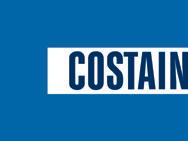
The project also involved the recontrolling of nearby Littlehaven crossing to the Three Bridges ASC, and was the highest-scoring scheme in the Route to Gold safety initiative for Period 6.
“We experienced many challenges, from close residential properties

to material delays due to global supply issues, however a strong collaborative approach and constant stakeholder engagement, overcame all these issues,” said Mark Stacey, senior construction manager.
“Having a good, clear understanding and trust on site leads to safety on site and quality becomes the standard.


“It is also great to see staff talk more openly about mental health, which is great progress in the workplace.”
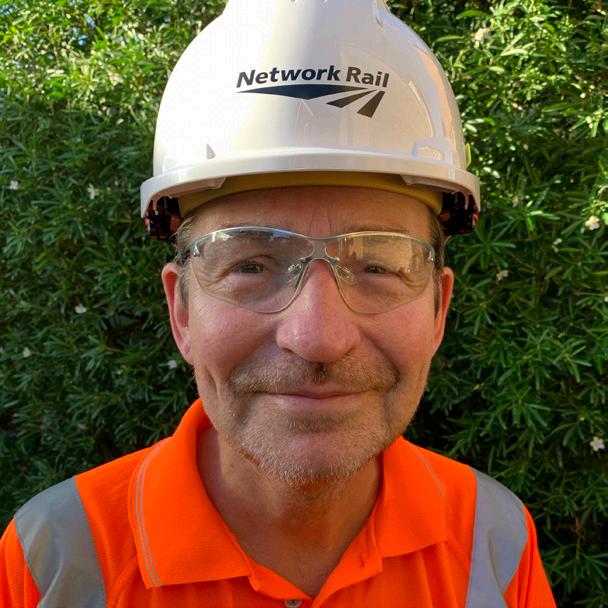
OUR protective clothing keeps us safe every day, and now you can have a say about what’s on offer.
Network Rail is looking to make some changes to the clothing in its personal protective equipment (PPE) catalogue to provide more options for its colleagues as well as for contractors and suppliers.

Some have requested different requirements due to things like disabilities, faith, age and gender. While the main purpose of PPE is to help protect our health and safety, it’s also important that it’s comfortable and works well with the tasks colleagues need to do.
To help get a better idea of the changes needed, rail colleagues can complete a short survey about how PPE can be improved.
Responses will be anonymous so you can be open and honest – all feedback helps!
Scan the QR code to take part.
2 THE SHIELD ISSUE 37, NOVEMBER 2022
First Person This paper is produced for:
Written and designed by: beetroot.co.uk Want us to feature your team? Get in touch at southernregioncomms@networkrail.co.uk
Paul Burr, principal construction manager, Southern Capital Delivery, Network Rail
RECYCLED RAIL WASTE HELPS PUPILS LEARN AND GROW A CHANGE OF CLOTHING? HAVE YOUR SAY ABOUT PPE HAVE A MERRY CHRISTMAS – BUT THINK BEFORE YOU DRINK LEVEL BEST IN SUSSEX
DON’T SNOOZE AND LOSE SIX STEPS TO FIGHT FATIGUE
FATIGUE is one of the biggest causes of accidents in the transport, construction and maintenance industries.
Described as a state of extreme tiredness resulting from physical or mental exhaustion, it can lead to reduced alertness, impaired decisionmaking and poor judgement of distance and speed. On a railway site that’s clearly a serious risk. It’s also bad for your general health and can cause sore or aching muscles, appetite loss and reduced immune sys tem function.
The main causes of fatigue are a lack of sleep or poor quality of sleep with lots of interruptions, long working hours or poorly designed shift work with inadequate breaks during the working day. There are already some simple steps you can take to reduce the risk, raise concerns and get support…
SPEAK UP
If you are concerned that you or a colleague is suffering with symptoms of fatigue, raise this with your line manager or supervisor.
It is everyone’s responsibility to manage fatigue and part of that is being empowered to say it. You should be able to put your hand up and say “I am fatigued” or highlight concerns about others to your line manager or the person in charge of the work being done or scheduled. This will enable measures to be put in place to ensure both your safety and the safety of those you are working with and who may be affected by the things you do or fail to do.
Call: 08081 964 505 (24/7) Webchat: www.PAM-assist.co.uk (access code is NWR1) to type
ISSUE 37, NOVEMBER 2022 THE SHIELD 3 NEVER UNDERTAKE ANY JOB UNLESS YOU HAVE BEEN TRAINED AND ASSESSED AS COMPETENT
Toolbox Talk on the Southern Shield website contains information on the causes of fatigue. You can find this at southernshield.co.uk
A
WILL BE ABSOLUTELY NO PENALTY OR BLAME FOR ANYONE PUTTING
PAM ASSIST NETWORK RAIL EMPLOYEE ASSISTANCE
THERE
THEIR HAND UP.
PROGRAMME
rather than talk. CRITICAL INCIDENTS Support for people impacted by traumatic events such as near misses or fatalities:
505 for support
THE HUB OF HOPE The UK’s leading mental health support database. It is provided by the national mental health charity.
RAILWAY CHAPLAINS Regionally-based chaplains aim to be an impartial ‘friend’ for those who work on the railways, regardless of faith, gender, sexual orientation. Call: 0203 887 7000 www.railwaymission.org Plenty of sleep Get at least seven to eight hours a day. 1 2 3 4 5 6 1 2 3 5 6 1 2 3 4 5 6 1 2 3 5 6 1 2 3 4 5 6 1 2 3 4 5 6 Take a break Make sure you get frequent breaks throughout the day. Eat well to stay well A healthy diet that promotes longer-lasting energy. Avoid junk food and drink plenty of water. Don’t drive drowsy Avoid driving if you feel tired, especially in bad weather where vision is impaired. Put down your mobile Avoid using technology 30 minutes before bed. Cut the coffee Avoid drinking caffeinated drinks four to five hours before bed as this can cause sleeplessness. From 29 October a new fatigue standard has been introduced to keep you safe and well rested, so we can all work together to reduce the risk of fatigue related accidents.
CI@pamwellbeing.co.uk (Mon-Fri 8am-5pm) or call 08081 964
24/7.
www.hubofhope.co.uk
WAD A SUCCESS!
SAFETY and performance go hand in hand. That’s been a familiar slogan on the railway in recent years, and it proved to be the case at Wadhurst Tunnel.


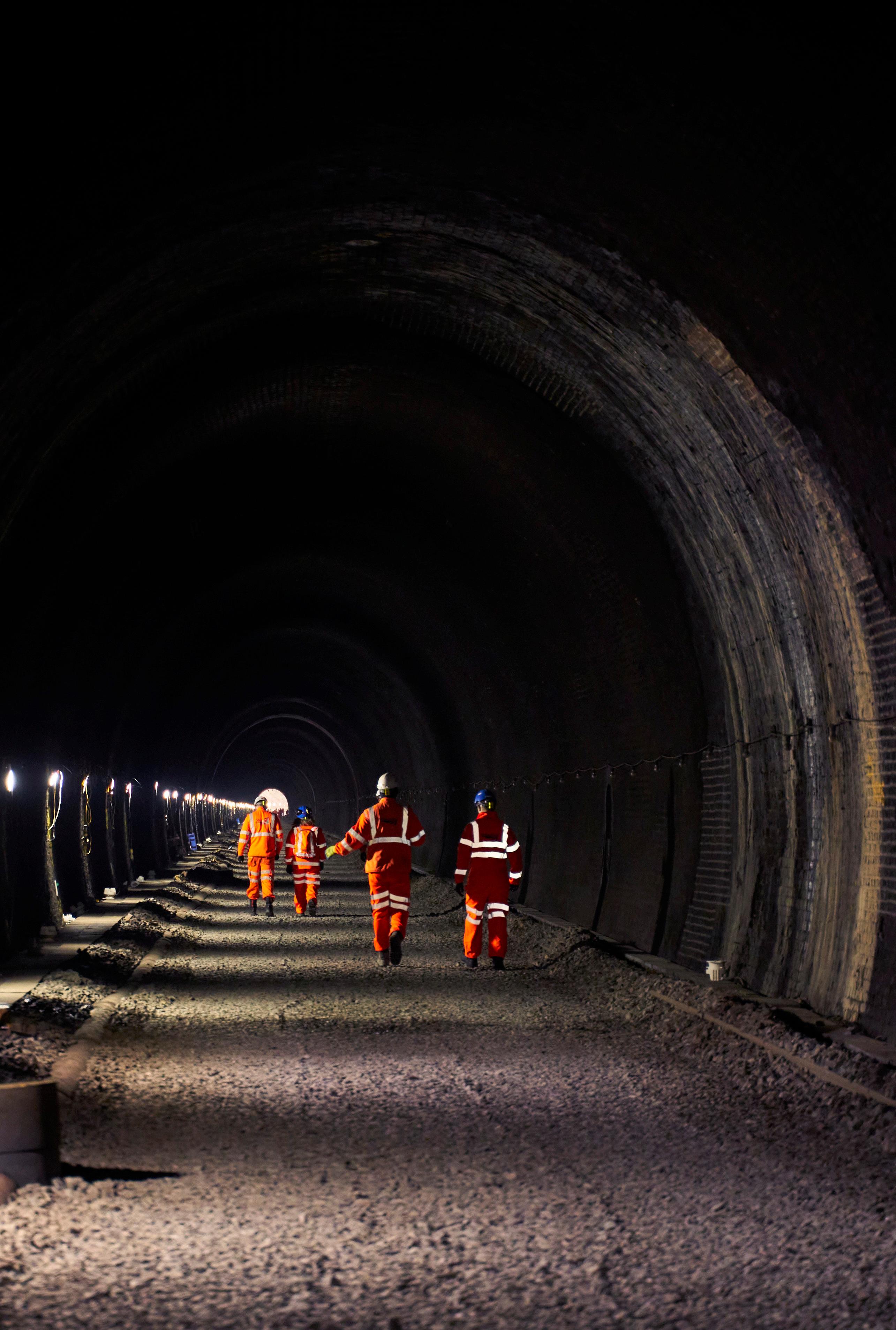



The latest series of works on the Kent Route near Tunbridge Wells, took place during a nine-day possession in October.
Having successfully stabilised the tunnel cutting in 2021 – as covered in The Shield this time last year –colleagues from Network Rail and Colas Rail were back on site from 23 to 30 October, renewing the track in the tunnel itself. As well as improving ride quality for passengers, the work will reduce delays due to track faults in the long term.
“The track components were coming to the end of their life and needed replacing,” said Selina Suri, project manager for Network Rail. “That meant removing rail, sleepers and ballast and renewing the whole line along 1,176 yards. Because it’s a single line tunnel we started digging from the middle and gradually worked out to either end, removing the spoil in two directions.
Being in a tunnel, working height restrictions are especially important with the plant involved. Dust is
also a safety issue, so a bespoke ventilation system was installed as part of the preparation.
“Another issue is the difficulty of communication,” added Selina. “There’s no phone signal so everything is done through radio. That’s fine but it has to be carefully managed to make sure there are no lapses.”
One of the biggest factors in keeping colleagues safe, Selina explained, was the level of planning involved and the lessons learned from previous tunnel works at Penge East. Having experienced colleagues was also important.
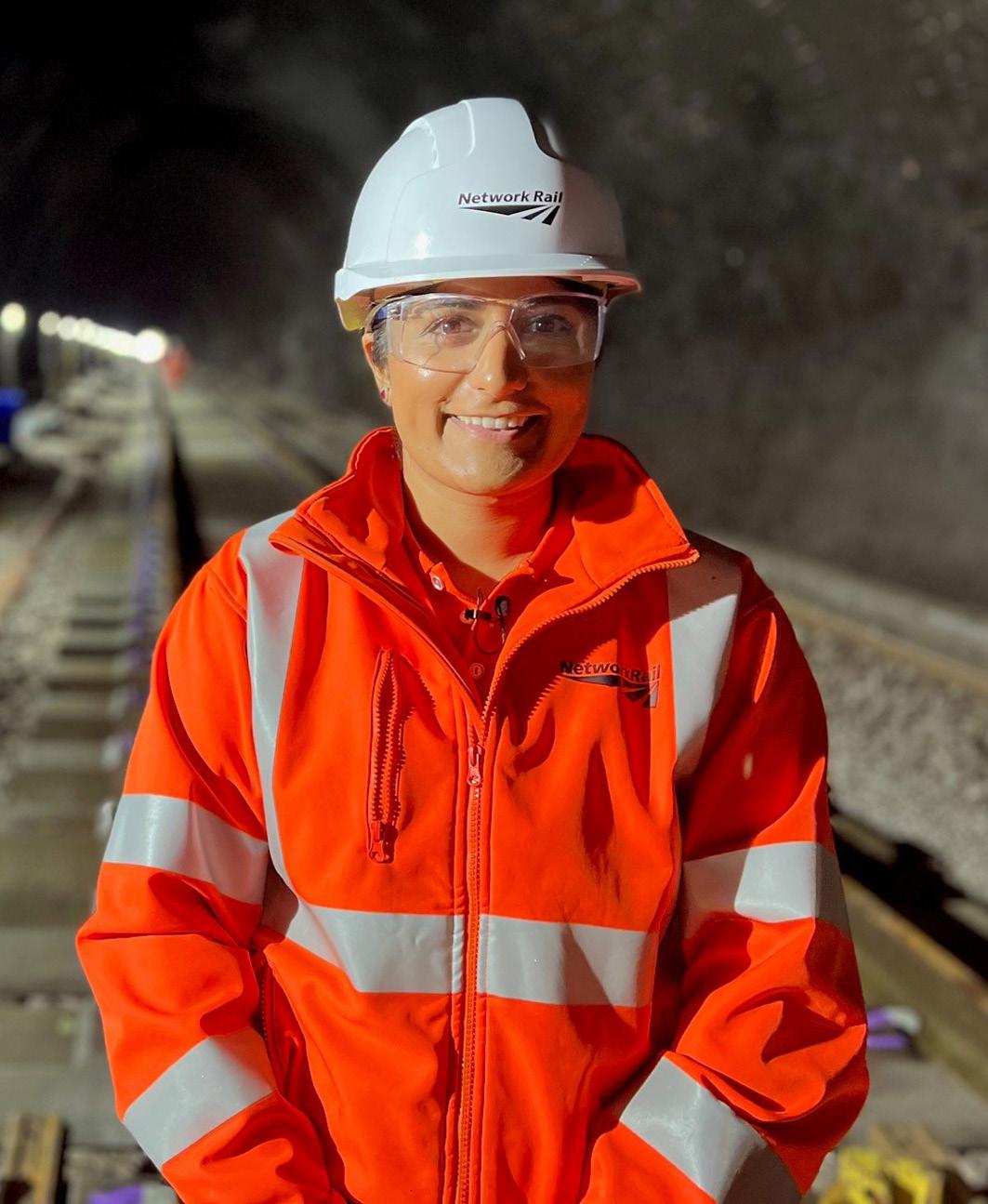
“Our partners here are all familiar with the safety procedures and Network Rail’s rules. We all know to challenge anything we see that’s unsafe – that’s become the culture across the business and among our partners.”
As well as the Wadhurst project, work also took place in nearby Mountfield Tunnel, where concreteset “slab track” needs repairing. Both projects formed part of work along a 15-mile section of the line.
Further work is due to take place in April 2023 to complete the programme.
4 THE SHIELD ISSUE 37, NOVEMBER 2022
enter the agreed exclusion zone
ON SITE Never
Project manager Selina Suri
Good planning, skilled workers and lessons learned enable tunnel project to complete quickly and safely

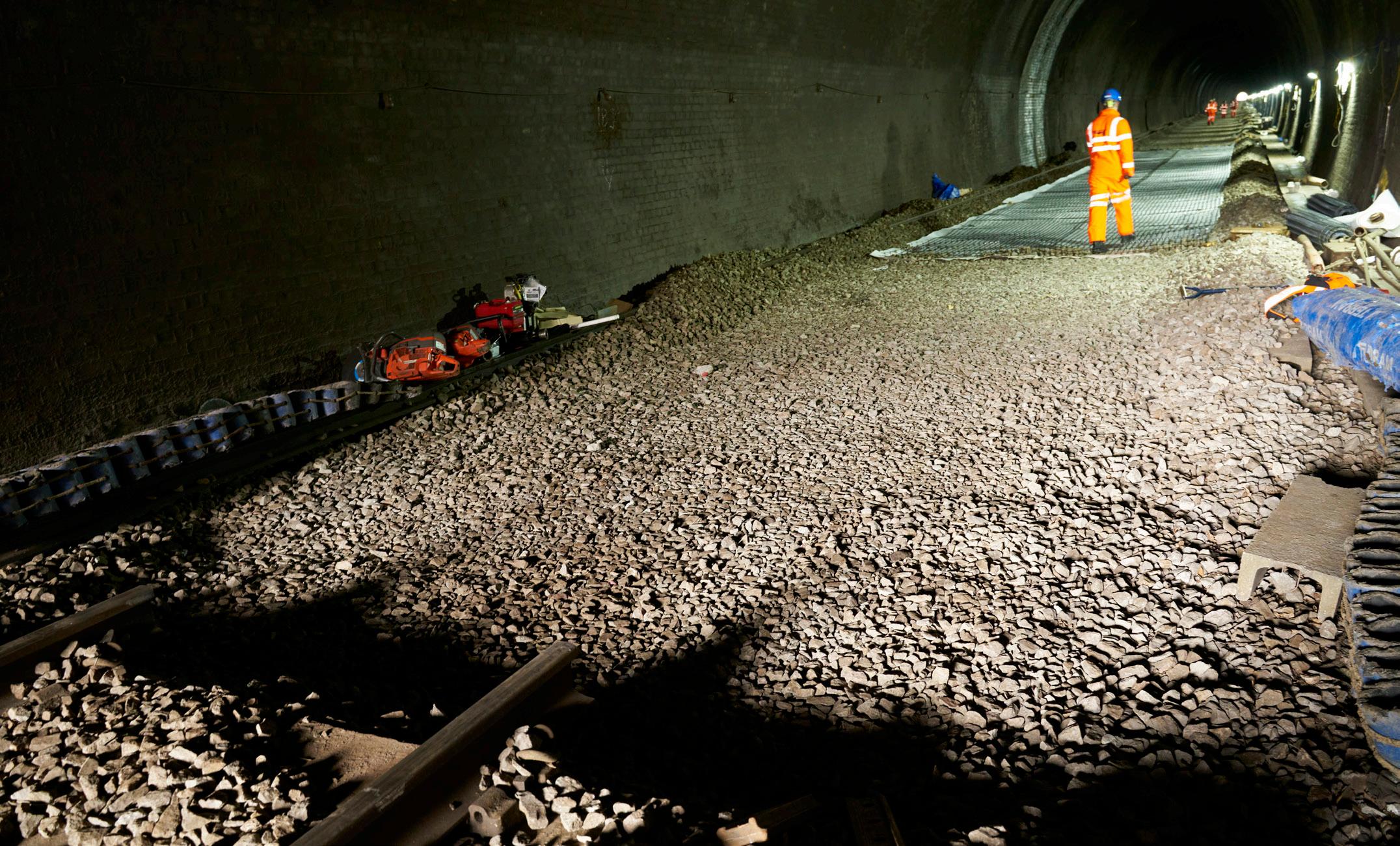





ISSUE 37, NOVEMBER 2022 THE SHIELD 5
unless directed to by the person in charge
Tunnel team: (left to right) James Pearce, Fiona Taylor, George Murrell, Doug Innes, Tyrone Williams
Project manager Tyrone Williams
Tight fit: Space was at a premium in the tunnel
SPEEDING




It’s not worth the risk
Hard hitting campaign targets speeding to drive home the message about safety on the road

IN THE rail industry, getting home safe every day doesn’t end when we leave the track side. Accidents on the road are one the main causes of injury to railway workers – it’s why safe driving features in Network Rail’s Lifesaving Rules.
One of the primary causes for a large number of road traffic collisions that lead to serious injury and worse, is speeding. Worryingly there has been an increase in the number of speeding incidents involving rail workers – not just in the Southern region but nationally.





For this reason, a series of posters has been developed and are being displayed at depots and worksites across the region. They carry a powerful reminder that breaking the speed limit even by a small amount can have serious consequences, not just for the driver and their passengers but for their loved ones too.
“The speeding posters really bring home the message just how detrimental speeding is,” says David Smith, senior programme manager for Network Rail.





“All of the activity involved in this campaign was developed in collaboration with representatives from external groups, such as the Rail Safety and Standards Board (RSSB), Driving for Better Business and National Highways, as this is a real industry issue.
“Speeding is against the law and is a direct breach of our Lifesaving Rules within Network Rail. If caught, you could find yourself subject to disciplinary action.”
Imagine not being able to drive to Mum’s famous Sunday roast ... or worse


Risks go up when you put your foot down
Imagine not being there at all
RISKSDOWN
SPEEDING It’s not worth the risk
Imagine
Risks go up when you put your foot down
6 THE SHIELD ISSUE 37, NOVEMBER 2022
the
a seat belt
Imagine having to tell them you can’t drive to movie night ... or worse
not being there at all SPEEDING It’s not worth the risk
RISKSDOWN
Always obey
speed limit and wear
DRIVE SAFE: Obeying the law is just one aspect of being safe and responsible driver. Check out our Drive Safe guide on the opposite page. NOT SO FAST!
It’s not worth the risk Imagine having to tell them you can’t drive them on holiday ... or worse Imagine not being here to tell them anything at all Risks go up when you put your foot down RISKSDOWN SPEEDING It’s not worth the risk Imagine not being able to drive the team to 5-a-side ... or worse Imagine not being there to play at all Risks go up when you put your foot down RISKSDOWN
SPEEDING
ISSUE 37, NOVEMBER 2022 THE SHIELD 7 Never work or drive while under the influence of drugs or alcohol ARRIVE SAFELY BACK ON THE ROAD Never work or drive while under the influence of drugs or alcohol PLAN YOUR ROUTE SERVICES 14 MILES = 27 MILES = 46 MILES = I’M VERY TIRED. I NEED SLEEP Always obey the speed limit and wear a seat belt 30 DIVERSION SERVICES WELCOME TAKE A BREAK NEXT LEFT I NEED A BREAK Never use a handheld or handsfree phone, or programme any other mobile device, while driving SERVICES HOTEL TRAFFIC ALERT: ROAD WORKS LET’S SHARE THE DRIVING BUS STOP TRAIN STATION SHOULD I CATCH THE TRAIN? SHOULD I TAKE THE BUS? AM I FIT TO DRIVE? DO I NEED TO DRIVE? Driving is one of the most dangerous activities that most of us undertake. Do you always plan your journeys properly so that you get to your destination safely? Here are some of the things you should think about before and during your journey. AVOID DRIVING WHILE TIRED
LISTEN TO THESE LITTLE LIFESAVERS
WE ALL want to get everyone home safe every day. Whether it’s our family, friends, pets, or even plants – every one of us has a reason for this.
For Jonathan Smith, a Network Rail mobile operations manager, it’s his family, especially his four children. Two of them, Reggie and Teddy, are part of a new campaign called the Little Lifesavers, reminding all us adults of the all-important Lifesaving Rules. They feature in a video aimed at front line rail workers across the country.
“My number one priority is my family,” says Jonathan. “I follow the Lifesaving Rules so I can get home safely to my children.
“Safety is something I take seriously in my role as most of the time I am responding to an unplanned incident. In these situations, it’s down to me to set up a safe system of work to keep everyone safe, and to make sure they get home safely. I do this by following the Lifesaving Rules.
“When I’m doing anything, I always pause and make sure I’m doing everything possible to eliminate the risk of injury to anyone. This includes making sure that I’m doing what I’m trained and competent to do and challenging unsafe working practices.”
LIFE CHANGING
Sadly, Jonathan has seen first-hand what can happen in an unsafe environment and how those situations change more than just one person’s life.
“It affects everyone around them, their colleagues, and their families,” he says.
“If I can help create a safe environment, to help stop this happening, I can go home happy. Each of the Lifesaving Rules helps me do this.”
Jonathan encouraged everyone to refresh themselves with these rules, the updated work safe procedure, close call app and speak
out procedure – one of the easiest ways to help keep each other safe is to challenge unsafe working practices.
He added: “Following the Lifesaving Rules while I’m at work means that when I go home to my children, I can feel proud that I’ve worked in the safest way for my family and my colleagues.”

OUR LIFESAVING RULES
Watch your speed: Young campaigners Reggie and Teddy

Always be sure the required plans and permits are in place, before you start a job or go on or near the line
Never undertake any job unless you have been trained and assessed as competent
Never use a hand-held or handsfree phone, or programme any other mobile device, while driving
Always test before applying earths or straps
Always use equipment that is fit for its intended purpose
Never work or drive while under the influence of drugs or alcohol
Always obey the speed limit and wear a seat belt
Never assume equipment is isolated – always test before touch
Always use a safety harness when working at height, unless other protection is in place
Never enter the agreed exclusion zone unless directed to by the person in charge
8 THE SHIELD ISSUE 37, NOVEMBER 2022 What do you think? Get in touch – southernregioncomms@networkrail.co.uk
Reggie and Teddy have an important set of rules for their dad – and all of his railway colleagues
Home safe: Jonathan Smith and family










































